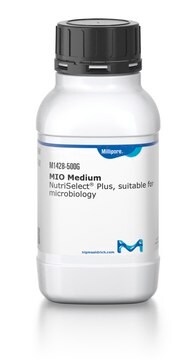05039
Agar
suitable for microbiology
Synonym(s):
Agar-agar, Gum agar
About This Item
Recommended Products
sterility
non-sterile
Quality Level
form
powder
shelf life
limited shelf life, expiry date on the label
packaging
pkg of 50 g
pkg of 500 g
storage condition
(Tightly closed)
ign. residue
≤5%
loss
≤12% loss on drying
pH
6-7.5 (1.5%after autoclaving)
mp
85-95 °C
transition temp
gel point 33-37 °C (1.5% solution, after autoclaving)
gel strength
>800 g/cm2 (1.5% gel, Nikkan, after autoclaving)
solubility
H2O: 1.5% at 70 °C, clear to very faintly turbid, almost colorless
application(s)
agriculture
microbiology
InChI
1S/C14H24O9/c1-5-8(16)13-11(7(21-5)4-20-13)23-14-10(18)12(19-2)9(17)6(3-15)22-14/h5-18H,3-4H2,1-2H3/t5?,6-,7?,8-,9+,10-,11?,12+,13+,14?/m1/s1
InChI key
GYYDPBCUIJTIBM-DYOGSRDZSA-N
Looking for similar products? Visit Product Comparison Guide
General description
Application
Storage Class Code
11 - Combustible Solids
WGK
WGK 1
Personal Protective Equipment
Choose from one of the most recent versions:
Already Own This Product?
Find documentation for the products that you have recently purchased in the Document Library.
Customers Also Viewed
Our team of scientists has experience in all areas of research including Life Science, Material Science, Chemical Synthesis, Chromatography, Analytical and many others.
Contact Technical Service


